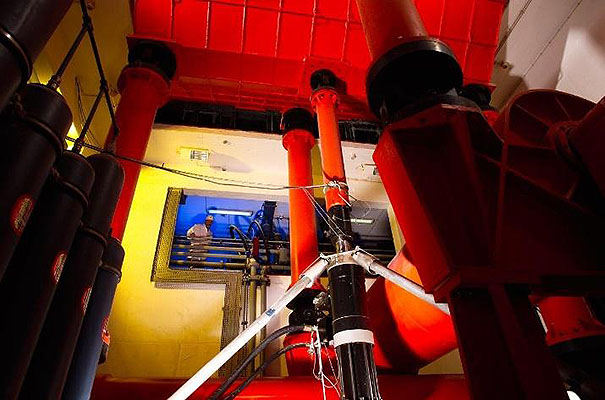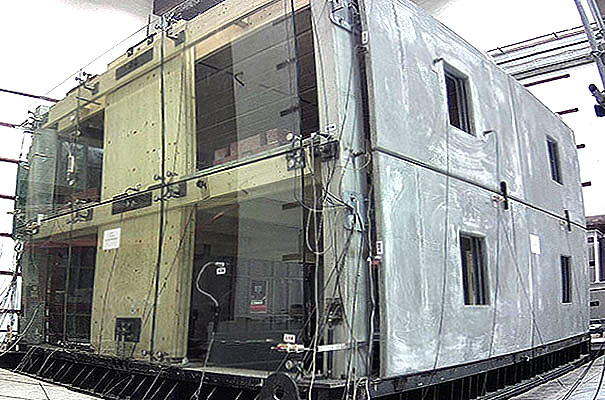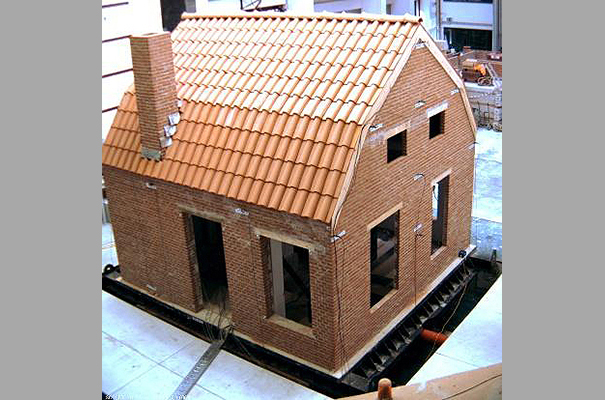The control of ST3D is fully digital, allowing input displacements of any form in a frequency range of 0-40Hz. The digital control hardware and software has been continuously upgraded into an advanced and open platform, whereby the introduction of new control strategies or the implementation of new test strategies (e.g., hybrid simulations) is facilitated. The acquisition system allows a large number of physical variables (such as pressures, forces, accelerations, displacements, strains, etc.) to be monitored, using the extensive instrumentation available or specially developed one. The possibility of performing digital image processing for motion tracking using a set of synchronised fast megapixel cameras is under development. ST3D was designed specifically for testing structures and components up to collapse or near-collapse conditions. It has a large capacity in terms of payload (max. weight of 40 tonnes), allowing tests on medium-sized structures or larger structures at reduced scale. A special feature of this facility is that ST3D is surrounded by three reaction walls, which can be used for different test setups. As an example, substructuring tests may be performed by introducing additional actuators or connections between the reaction walls and the model on ST3D, in order to simulate the dynamic reaction of a numerical substructure on the physical model.
Services currently offered by the infrastructure:
This facility has participated in a large number of European and National R&D&I projects, namely offering transnational access since EU R&D&I FP2. Tests performed therein include: development and qualification of construction systems in reinforced concrete, steel, masonry or wood; seismic response control systems; geotechnical tests using a laminar box; retrofitting schemes; sustainable construction materials. Experimental tests are often complemented with the development and calibration of numerical models and with the experimental assessment of the structural vulnerability and limit states identification for Bayesian updating of seismic fragilities. There is also a long tradition of developing experimental methods and instrumentation devices, used for structural monitoring or for substructuring tests. As a measure of the widespread interest in using this facility, previous transnational access demand has always been significantly larger than the availability of the infrastructure.
The services provided to users of the infrastructure are: a) Assistance in the definition and design of the test model and experimental setup; b) Fabrication of test models, including automatic controlled sand pouring for geotechnical models; c) Preliminary destructive or non-destructive tests for identification of material properties; d) Assistance in the design, calibration and implementation of instrumentation, providing state-of-the-art sensors, materials and components and the necessary workmanship; e) Data acquisition systems; f) Assistance in the definition of input signals; g) Use of analytical tools to support the design of the specimen and the test campaign; h) Photographic and video records of the test campaign; i) Data processing, analysis and interpretation of test results, namely using techniques for modal assessment and system identification; j) A computer network with access to advanced computer codes for static and dynamic analysis of structures; k) A data repository web portal, where all test results will be made available to the general public; and l) Advanced training in topics specific to users’ interest and to the project to which experimental access is offered.
DESCRIPTION OF WORK:
Modality of access under this proposal:
Access to ST3D will be given to projects focused on seismic risk reduction involving the seismic response of scaled or real-scale structures and geotechnical systems. Alternatively, innovative testing techniques such as those developed for hybrid dynamic simulations will be promoted and applied on a pilot basis. Finally, users interested in shaking table control issues may submit proposals for software implementation, development and testing.
Users will be given extensive access to the infrastructure, with visit durations ranging from a few days up to a few weeks, depending on the complexity of the test and the type of activities carried out: from the design and construction of the test model and of the instrumentation, to the execution of the tests and post-processing and interpretation of results. Users will be integrated into the schedule of the infrastructure, receiving all the support needed to carry out their project. A user support team will be allocated to each user in order to help to develop and execute their test programme. A long-term schedule of the experimental tests is continuously updated along the course of the project. Any conflict between a new user activity and the ones already assigned to the infrastructure is thus prevented.
The unit of access being offered corresponds to an ‘access day’. An access day is defined as a day when ST3D is being used without the test specimen present in order to tune the shaking table motion, a day when the test is carried out with the specimen on ST3D, or a day when the specimen is being mounted, instrumented or dismounted from ST3D. The experimental activities performed during an access day typically involve the use of ST3D, the crane, the control and/or data acquisition systems of the laboratory.
All other activities and services provided to users and carried out before or/and after the delivery of access are not accounted as being part of an access day, although they are included in its cost. These activities include the definition, preparation and programming of the test campaign, the instrumentation planning, and the design, construction, transportation, demolition and disposal of the test model.
A log book will be maintained to record the dates and actions delivered, indicating the type of tests performed and the project or user group to which access is offered. Projects belonging to ERIES as well as to other research programmes of LNEC will be recorded in the log book. During an access day, a full day, equivalent to 7 working hours, will be recorded for the project to which access is delivered.
It is expected that the projects carried out under ERIES will vary in size, with larger projects requiring a higher number of access days, so that the total number of projects and the number of access days per project may vary. On the other hand, the costs associated with each user may also vary significantly. Therefore, LNEC will use actual costs for declaring its access costs.
Support offered under this proposal:
The external users of the facility may count on the full collaboration of LNEC’s staff for technical and scientific assistance. The staff plays an important role on all phases of the experimental studies and comprises senior research officers, assistant and junior researchers, doctoral students and technicians, working in a multidisciplinary environment and having a large experience in earthquake engineering topics. After receiving the necessary training, users will be able to fully participate in the test preparation, execution, data acquisition and interpretation. LNEC will provide assistance for organising the logistics for transportation, accommodation and subsistence, which will be reimbursed to users through a dedicated budget for T&S, and will also provide facilities for the organisation of meetings and workshops. The strong ties with the international research community are important for the existing multidisciplinary, dynamic and vibrant research environment, but LNEC’s complementary facilities (e.g., library, social centre, high-performance grid computing centre, high-speed internet connections) also contribute to it.
Outreach to new users: LNEC hosts several international scientific meetings promoting the connection between research and industry, particularly SMEs, and fostering the joint preparation and execution of R&D&I projects. EU funding is paramount for potential users to start performing shaking table tests, since these are at the forefront of seismic experimental research but are costly activities. In what concerns the advertisement of opportunities, LNEC maintains a website publicising its activities and where announcements for open research funding calls are posted. LNEC is also present on all major social media (Facebook, LinkedIn, Twitter) targeting at specific audiences.
Review procedure under this proposal:
For details on the TA evaluation process, please refer to Task 1.2 of WP1 and the process followed by the TA-SEP in particular.






